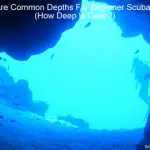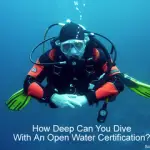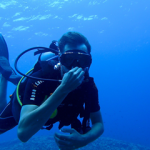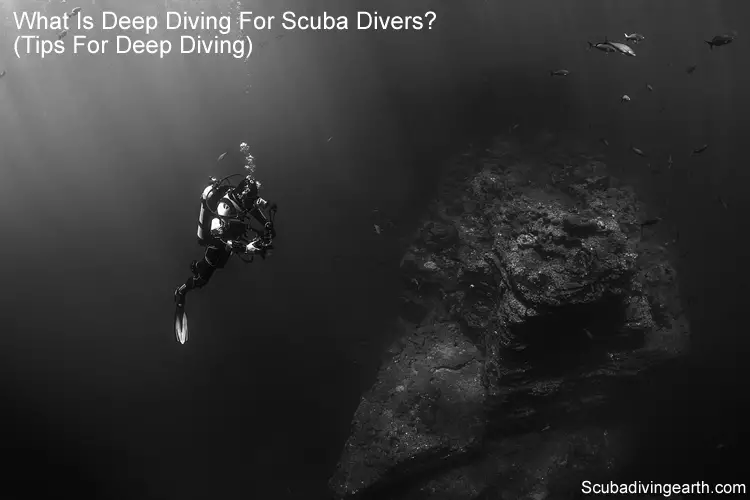
What is considered a deep dive and 26 pro tips for beginner deep divers
Deep diving isn’t for everyone, but sometimes you have to go deeper to see what you want.
It is for that reason why it’s important to understand what is considered deep diving? Deep diving is underwater diving to depths beyond first stage diver training. For PADI and NAUI this means deeper than 18 metres (60 feet) and BSAC deeper than 20 metres (66 feet). But in practice deep diving is beyond 30 metres (98 feet) when divers can experience nitrogen narcosis.
The best way to do more diving is to book yourself on a scuba diving liveaboard. You can check the latest and best deals on liveaboards using the following window:

What is deep diving according to PADI?
PADI diver training begins with Open Water Diver. Open Water Divers with PADI are certified to dive at depths of up to 18 metres (60 feet). Which means that anything deep that 18 metres is considered a deep dive.
If you want to dive deeper than 18 metres with PADI this requires additional training and certification.
With PADI the next stage is an Advanced Open Water Diver (AOWD). An AOWD can dive to 30 metres (98 feet). But if you want to dive deeper than 30 metres, you may want to do the next course.
The PADI Deep Diver course certifies you to dive to 40 metres (130 feet). The PADI Deep Diver course includes train on the following skills and equipment:
- Specialised deep diving equipment.
- Deep dive planning, buddy contact procedures, safety considerations and buoyancy control.
- Managing your gas supply and dealing with gas narcosis.
You be interested to read this article about what depth nitrogen narcosis occurs. You may be surprised by what’s explained in the article.
Which means if you want to dive beyond 40 metres you will need to take their Technical Diving course. On PADI’s Tech Diving course you learn about the following additional skills and equipment:
- Increased Range: Exploring deeper than 40 metres/130 feet.
- Increased Diving Environments: Diving in caves, shipwrecks or other special environments.
- Specialised Equipment: Using highly specialized equipment, like a closed or semi-closed circuit rebreather.
- Increased Skills: Using specialized gas mixtures and decompression procedures.
What is deep diving according to BSAC?
BSAC diver training begins with Ocean Diver. Ocean Divers with BSAC are certified to dive at depths of up to 20 metres (66 feet). Which means that anything deep that 20 metres is considered a deep dive.
If you want to dive deeper than 20 metres with BSAC this requires additional training and certification.
The next stage in the training with BSAC is Sport Diver. The Sport Diver level of scuba diver qualification limits your dive depth to 35 metres (115 feet). But if you want to dive deeper than 35 metres with BSAC, you may want to do the next course.
BSAC don’t run a specific deep diving course but instead you can train to become a Dive Leader. A BSAC Dive Leader can dive to depths of up to 50 metres (164 feet).
If you want to dive beyond 50 metres BSAC also offer technical diving course. These tech diving course are for those divers who want to extend their limits underwater.
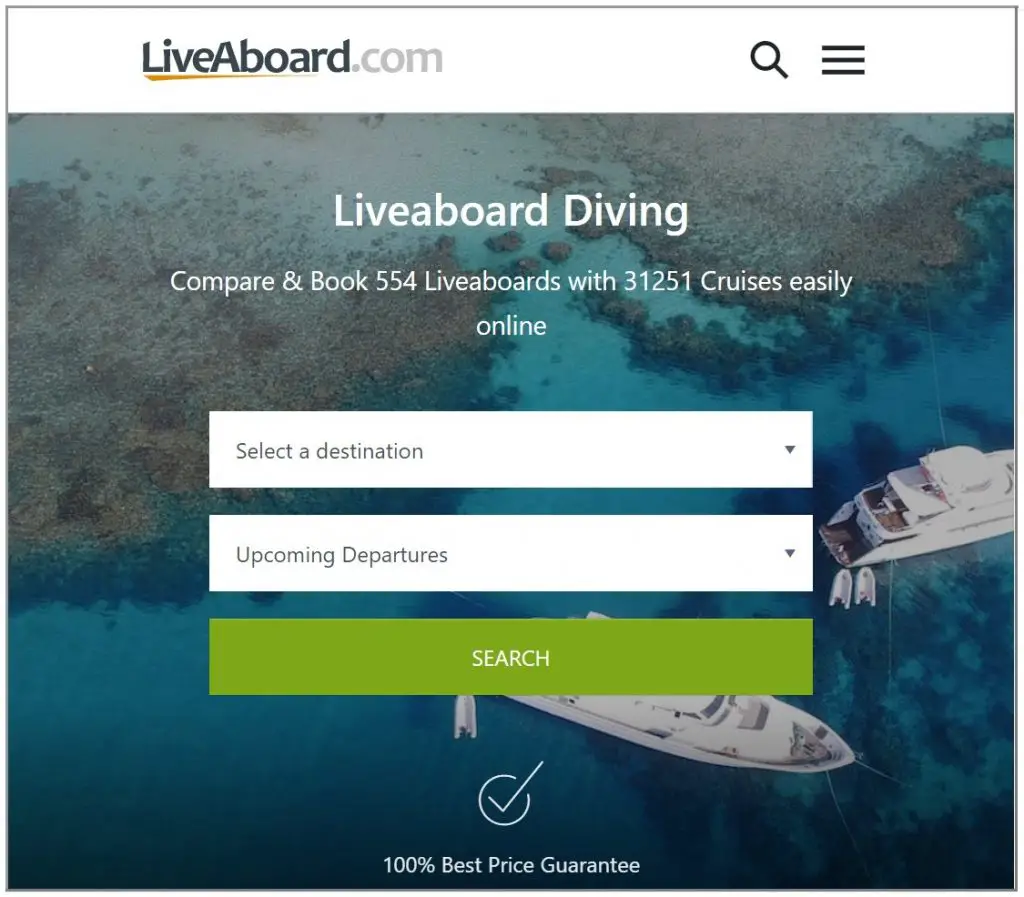
What is deep diving according to NAUI?
NAUI diver training begins with Open Water Scuba Diver. Open Water Scuba Divers with NAUI are certified to dive at depths of up to 18 metres (60 feet). Which means that anything deep that 18 metres is considered a deep dive.
If you want to dive deeper than 18 metres with NAUI this requires additional training and certification.
With NAUI the next stage is an Advanced Scuba Diver. An Advance Scuba Diver can dive to 40 metres (131 feet). But if you want to dive deeper than 30 metres, you may want to do the next course.
The NAUI offer technical diving courses too for those who wish to diver deeper than 40 metres. NAUI also offer a Deep Diver course which includes training on decompression procedures including nitrogen narcosis and decompression sickness. It also includes training on the use of dive computers and how to avoid the need for stage decompression when diving beyond 40 metres.
What is deep diving according to SSI?
SSI diver training begins with Open Water Scuba Diver. Open Water Scuba Divers with SSI are certified to dive at depths of up to 18 metres (60 feet). Which means that anything deep that 18 metres is considered a deep dive.
If you want to dive deeper than 18 metres with SSI this requires additional training and certification.
With SSII the next stage is to become an SRC Extended Range diver or an Extended Range Nitrox Diving Instructor. Both SSI Extended Range Diving courses certify you to dive to a depth of up to 40 metres (131 feet). But if you want to dive deeper than 40 metres, you may want to do the next course.
The SSI offer the Extended Range (Trimix) Instructor course which has a maximum dive depth of 45 metres (145 feet). SSI also have technical diving courses with their CCR Technical Extended Range course which trains you to independently plan and conduct unlimited decompression dives to depths of up to 60 meters (200 feet).
Technical scuba divers often dive deeper than even 60 metres (200 feet). But to achieve these depths they use either mixed gases or rebreathers. All the above diving organisations offer rebreather courses and mixed gas courses.
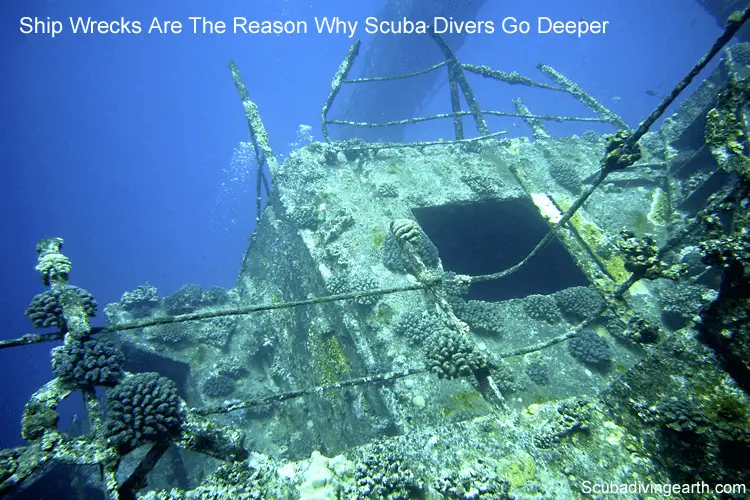
Why would you dive deeper than 18-20 metres (60-66 feet)?
Deep diving is not about simply wanting to dive deeper. But is instead about what you want to see at the depth you choose to dive. For example, many scuba divers love to wreck dive.
The UK has more wrecks around its coast per mile of coast line than anywhere else in the world. Which is as a result of the first and second world wars.
Also, Truk Lagoon comes to mind when we talk about deep wrecks. If you love wrecks you should look into scuba diving Truk Lagoon. This article is about how deep are the Truk Lagoon. The article includes a handy table of wreck depths. Also, if you want to dive Truk by liveaboard, this article is a review of the Truk Master Liveaboard.
A taster of Truk Lagoon for you:
Superb wrecks are what liveaboard diving in Truk Lagoon (Chuuk Lagoon), is all about. Truk Lagoon’s ocean floor is so full of amazing World War II wrecks and the place so secluded it is a picture-perfect place for scuba diving by liveaboard. When scanning Truk Lagoon, sipping a drink during surface intervals, it may be difficult to fathom that at the bottom of this calm blue atoll more than 60 wrecks violently found their final resting place among its amazing coral reefs and marine life.
To properly experience wrecks at depth you need to consider decompression stop diving. Bottom time for deeper scuba dives is so limited on a no decompression stop dive you don’t have much time to see much.

Deep diving isn’t only about wreck diving
There are more reasons other than wreck diving for diving deeper than 18-20 metres (60-66 feet). For example, there a few great dives in the Red Sea when you dive deeper to see and scuba dive with sharks.
Two great examples of this are the Elphinstone Reef and The Brothers in the Red Sea.
Search for your favourite Red Sea Liveaboard:
Red Sea dive liveaboards table
This list of Red Sea liveaboards is in descending customer rating order, followed by Scuba Diving Luxury Rating (SDE Lux Rating, see below), so the liveaboards with the highest customer rating and the best SDE lux rating will be at the top of the list. If you want to change the list order, use the “Sort by” dropdown below.
| Discover Liveaboard | Customer Rating | SDE Lux Rating % | Flexible Booking | Dive Courses | Dietary Requirements | Nitrox | Gear Rental | |
|---|---|---|---|---|---|---|---|---|
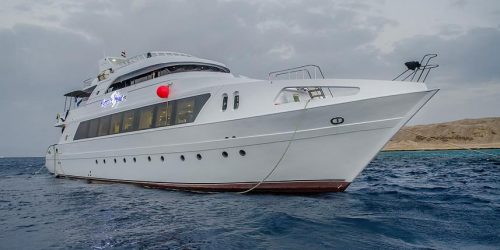 | Review: MY Hammerhead I; Book: MY Hammerhead I | 10 | 71% | YES | YES | YES | YES | YES |
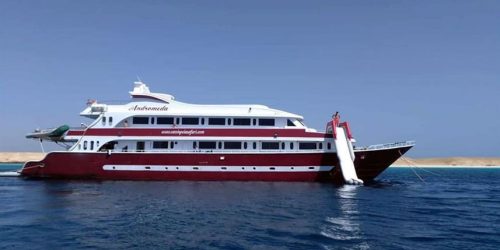 | Review: MV Andromeda; Book: MV Andromeda | 10 | 65% | NO | YES | YES | YES | YES |
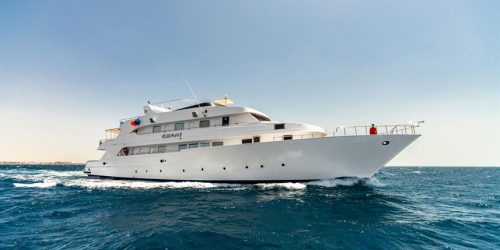 | Review: MV Ghani; Book: MV Ghani | 10 | 50% | YES | YES | YES | YES | YES |
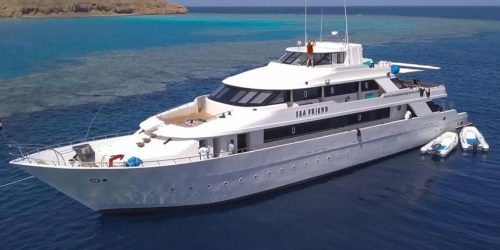 | Review: MY Sea Friend; Book: MY Sea Friend | 9.6 | 71% | YES | YES | YES | YES | YES |
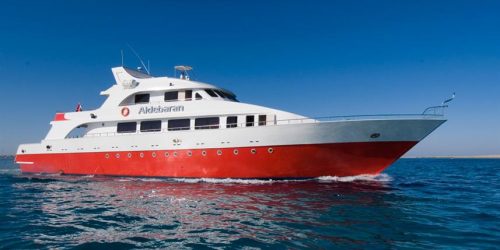 | Review: MY Aldebaran; Book: MY Aldebaran | 9.6 | 67% | YES | YES | YES | YES | YES |
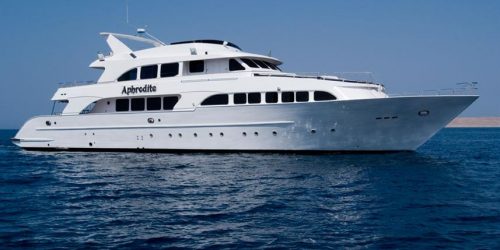 | Review: MY Aphrodite; Book: MY Aphrodite | 9.5 | 88% | YES | YES | YES | YES | YES |
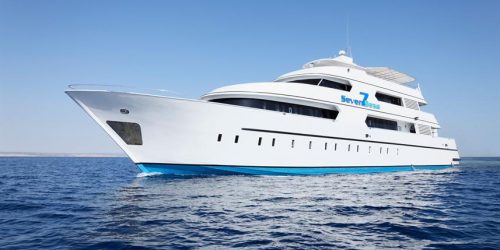 | Review: MY Seven Seas; Book: MY Seven Seas | 9.5 | 87% | YES | YES | YES | YES | YES |
The Scuba Diving Earth Luxury Rating (SDE Lux Rating) is explained on each liveaboard review when you click the “Discover Liveaboard” link, and is my own Liveaboard Luxury Rating I’ve assigned to all liveaboards. Choosing between liveaboards is helped by customer scores, and if you get stuck choosing between two or three liveaboards, where each one has a high customer score out of 10, you can use the SDE Luxury Rating to help narrow down your choice.
Think about it like using Booking.com when searching for the best hotel. Booking.com also use a customer score where each customer rates hotels out of 10. This is similar to the liveaboard customer rating, which is also rated out of 10. But let’s say you only like to stay in hotels rated 8 and above on Booking.com, but you also want the hotel to have WIFI or parking, or to have a swimming pool etc. The features each hotel has is usually secondary to the score out of 10.
The Elphinstone Reef is best at the northern tip of the reef. The dive is to around 30-35 metres (98-115 feet). The coral plateau sits at around 42 metres (138 feet), but with a bit of care and experienced diving you can get to a part of the plateau that’s at around 30 metres (98 feet). You’ll be blessed with the sights of sharks. These include hammerhead sharks, oceanic white tip sharks and if you’re luck thresher sharks.
To wet your appetite for a deep dive on Elphinstone reef:
Liveaboard with Deep Blue Cruises, M/Y Thunderbird. 3.01.2018 – „Sha`ab Abu Hamra“ Elphinstone Reef. The Elphinstone Reef is also famous for being one of the few places on Earth where you can dive with the Oceanic Whitetip Shark as well as Hammerhead Sharks. The best chances to spot an Oceanic Whitetip Shark (Longimanus) are from October to December. Manta Rays (mainly from May to August), Dolphins and Tiger Sharks can also sometimes be spotted. In addition to these giants, there are also plenty of pelagic fishes like trevallies, Barracudas and Tunas.
Is deep diving dangerous and what are the risks?
Deep diving should not be dangerous if you get certified to dive deep and dive using recommended safe diving practices. But deep diving does come with a higher level of risk when compared to shallower dives, as it usually involves a higher risk of decompression sickness and nitrogen narcosis.
The deeper you dive the more risks are associated with the dive. you might like to read this article Emergency decompression stop vs safety stop. In it I explain in a bit more detail about deep diving and decompression stops.
The main risk is a fast ascent from depth. A fast ascent risks the formation nitrogen bubbles. This can be extremely dangerous and is known as The Bends or Decompression Sickness.
The deeper the dive the more nitrogen gets dissolved into your body’s tissues. Which means your dive time has to be cut short or the dive must include decompression stops. But decompression stops increase the risk.
Deep diving tips
1. Deep diving is about safety first
Safety should be your top priority on all dives and deep diving is no exception. You might like to read these 27 rules for safe scuba diving as a refresher.
But as the risks are higher on deeper dives you should be especially careful. Get the extra training required for this specialised scuba diving. Build your diving depths slowly.
2. Planning your deep dive carefully
All deep dives should be carefully planned. The planning includes:
- The maximum depth.
- Bottom time.
- Type of air mixture.
- Planning decompression stops.
- Amount of gas required for descent time, the bottom time, ascent time and decompression stop(s) time.
Decompression tables should be used for this dive planning. These tables will provide the bottom time for each depth and how long before reaching saturation point and the point at which a decompression stop is required on the ascent.
3. Consider the diving conditions before a deeper dive
When you’re planning your dive consider where you are diving. Diving in the blue waters of the Caribbean or the Red Sea is a totally different ball game to diving at depth in the cold murky waters of somewhere like the UK.
If you’re diving in colder waters you’ll have more have better thermal protection in the form of a semi drysuit or a drysuit.
In UK waters there are also currents and tides to consider and slack time. You don’t want to be diving on any wreck when the tide is running. Let alone deep diving on a wreck at 40 plus metres (130 plus feet).
The other consideration is the visibility of the water.
4. Consider diver support and additional safety as a part of your dive plan
Consider additional safety tips. For example the dive boat should always have a supply of oxygen on board. This may be needed to administer to a scuba diver who has come up too quickly from a scuba dive.
Also, consider the distance from your nearest barometric chamber or decompression chamber. These are extra safety precautions to allow for anything going wrong.
5. Plan the deepest dive as your first or only dive of the day
The deepest dive of the day should always be the first one you do. However, if you are planning an extra deep dive this should be the one and only dive for the day.
6. Consider a decompression station or a hang bar for the end of the deep dive
You may also consider the option of a hang bar, which can make it easier for divers to decompress. A hang bar is a bar set at the required decompression stop depth and is hung from the boat. Divers return to this and hold on until the end of their final decompression stop.
The other alternative is a diver station, which is also set at the decompression stop depth. But in this case with extra safety air. This option is probably only really required for much deeper diving of over 50 plus metres (164 plus feet).
7. Don’t dive deeper than your qualification level
Never dive any deeper than you’re trained and qualified to do. This is for your own safety.
Also travel insurance will only cover you to the depth of your qualification. If something were to happen on a dive and it turned out you were diving deeper than your qualification allows, your diving insurance will not cover you.
If you’re not covered by diving insurance this could be disastrous. Not only could you have been involved in a diver incident, but then your expenses would not be covered under the terms of your insurance.
8. Check your travel insurance for cover for deep dives
Check the maximum depth your travel or diving insurance covers. Most travel insurance policies cover to a maximum of 30 metres (98 feet). If you intend to dive deeper than 30 metres you will need specialist scuba diving insurance.
Never dive beyond your insurance limit.
9. Back up air supply for your deep dives
When you dive deeper it’s good safe diving practice to carry a spare air supply or ‘Pony Cylinder.’
This pony cylinder is only to be used in an emergency. It is not for a planned ascent and decompression stops.
10. Consider a technical diver course
Consider additional scuba diver education to learn how to dive with mixed gasses. These extend your range and will allow you to dive even deeper and explore those wrecks at deeper depths. If you like the idea of diving Truk Lagoon, this might be something to consider.
Very deep diving and extended dive times at depth are only for those experienced scuba divers who have the necessary training.
11. Consider a rebreather for deep diving
Another option for deep diving is a rebreather.
These require additional training and are a good option for extending your dive time. However, you’ll still need to carryout decompression stops on longer deep dives.
12. Use a delayed surface marker buoy to deploy at the end of your deep dive
Many wreck dives will have a fixed line to descend and ascend from the dive. Alternatively, the dive boat will send down a line or their anchor.
But if this isn’t the case (for example, you’re diving from a rib), then always take a delayed surface marker buoy (Surface Sausage). Use this to ascend safely at the end of the dive.
A Delayed SMB makes your ascent safer and easier and helps with decompression stops.
More Reading: What is a delayed surface marker buoy? (Safety diving equipment)
13. Prepare to send your delayed surface marker buoy early
Begin preparing your delayed surface marker buoy (Delayed SMB) early. Deploying your delayed SMB can take a few moments to fill and send to the surface. In the time it takes to fill the balloon (sausage) with air and the time it takes to reach the surface you are racking up more bottom time. And hence more decompression time.
If begin your deployment of your delayed SMB when your bottom time has already run out you’ll be adding time to your ascent and decompression stop times. This will impact on your air consumption.
More Reading: What is a surface marker buoy used for? (Safety diving equipment)
14. Take two Delayed SMB’s on a deep dive
Make sure as a dive buddy pair you both have a delayed SMB. This is so you both have your own line to ascend with. But of course ascend together and stop together for the same amount of time.
15. Delayed SMB maintenance
Make sure you maintain your Delayed SMB reel. Over time the sea water will encrust the mechanism and can cause it to jam. Make sure the real is in good working order before you dive. This avoids it jamming at the wrong time.
You will not normally have time to spend sorting this out on the bottom, as your air will begin to run down. The longer you’re on the bottom the faster your air will run out. Plus you’ll be racking up more decompression time.
16. Monitor your air very carefully on a deep dive
At depth your air consumption increases. Be careful to monitor your air consumption very carefully as no stop decompression time runs out very fast at depth.
Once you enter decompression stop time the amount of decompression time needed on your ascent will rack up very quickly. For your own safety monitor this very closely together with your air consumption.
You must make sure you have enough air to get you safely back to the surface with all the necessary decompression stops.
17. Take things very slowly when diving at depth
The deeper the dive the quicker you’ll consume your air. This is where conserving your air as a scuba dive comes into play and becomes extremely important.
You want your air to last as long as you can to extend the time. You want to have as much time as you can on the bottom to explore what you’ve gone down to see.
18. Monitor your bottom time at depth
This is similar to monitoring your air consumption. At depth your ‘no decompression stop time,‘ or the time you must stop for decompression on a decompression-stop-dive creeps up. This speeds up very quickly once you move into this zone.
Never exceed your planned bottom time.
19. Dive with better thermal insulation on deeper dives
The deeper you go the more likely you are to get cold. This is especially true if you dive in a wetsuit. The neoprene of a wetsuit gets crushed at depth and loses its insulating properties. If you are diving in colder water always dive in a drysuit at depth.
More Reading: What is the difference between a wetsuit and a dry suit?
20. Build up to deep dives
Your body needs to adapt to deeper dives. Never dive straight to depths deeper than 20 metres (66 feet) without first doing a few dives at this depth.
Increase your depth gradually. Then after you’ve done a few 20 metre (66 feet) dives dive to say 30 metres. Then gradually get deeper.
If you are regularly diving in any case you will be okay. But some think it’s okay to go on holiday or vacation and dive to 40+ metres (130+ feet) without any preparation. This is asking for trouble.
21. Know your equipment when deep diving
In this article on scuba diving equipment, I discuss the benefits of owning your own equipment. This is important for safety, as you need to be familiar in an emergency.
This is even more important at depth. At depth things happen very fast. The slightest mistake or if you go over your planned dive time can have serious ramifications.
If you know your scuba gear you are better equipped to deal with any situation. You’ll be familiar with where everything is and you’ll do things without having to think too much.
22. Only dive in matched buddy pairs on deep dives
Unless you are taking someone on their first deeper dive and you are adequately trained and certified to do so, you should only dive to the depth you are both certified to dive.
Never push the depth boundaries for any person. If your buddy can only dive to say 30 metres (98 feet) you need to limit the dive to this depth. This is even if your certification allows you to dive deeper.
More Reading: How do I get a dive buddy? (5 easy ways to find a dive buddy)
23. Are you going deep for the right reason
Deeper is not always better. Diving deep is not always necessary and should not be a macho competition thing.
For example, I now pretty much limit my scuba dives to between 30-40 metres (98-131 feet).
Only dive deeper if you have a good reason to do so. For example, diving the wrecks of Truk Lagoon. Whilst some of the wrecks are less than 30 metres (98 feet), many of the really good wrecks are below this. Some Truk Lagoon wrecks are at 50-60 metres (164-200 feet).
24. Be aware of nitrogen narcosis
Nitrogen narcosis is an alteration of consciousness at depth and is caused by the aesthetic affects of nitrogen.
Nitrogen narcosis can take on various symptoms. These can range from euphoria to depression or paranoia. Some people have been known to take their regulators from their mouths under its influence not realising what they are doing.
Be aware of the symptoms for yourself and for your dive buddy and watch out for them.
If you or your buddy experience nitrogen narcosis stop your descent. Try ascending slightly before continuing your descent. This can sometimes clear the symptoms. Symptoms of nitrogen narcosis often clear very quickly.
Preparing for a deep dive the night before will help. Getting a good night sleep will help to alleviate the onset of nitrogen narcosis.
25. Make sure you’re fully hydrated before deep diving
Decompression sickness can be affected by dehydration. Leading up to your dive make sure you drink plenty of water. Stay well hydrated to help prevent decompression sickness or the bends.
26. Invest in the right equipment for deeper diving
For you to dive deeper you’ll need special equipment. You consume more air at depth, which means you’ll need to take more air on your dive or use a rebreather. If you can’t afford a rebreather dive using a twin set of 12 litre (80 Cubic Foot) dive tanks.
More Reading: Do empty scuba tanks float? (This depends on the material they are made from)
For this you will need two separate regulators unless you have the dive tanks manifolded together.
27. Different dive computers
If you are diving with different dive computers always go with the more conservative computer. So if your buddy’s dive computer requires a longer decompression stop, both stop to decompress for the same time period.
It’s also prudent to carry out an extra safety stop at 5-6 metres (16-20 feet) for 3-5 minutes too.
How deep can you dive without decompression?
All dives require decompression as all dives are decompression dives. If divers do not follow correct decompression tables, they may end up with decompression sickness. To read more on this, please take a look at this article how deep can you dive without decompression.
What is the no decompression limit?
The no decompression stop limit is the amount of time a scuba diver can stay down at depth without the need for a decompression stop.
A decompression stop is stop at certain depths to aid decompression. On certain dive depths and depending on the length of time the scuba diver spends at those depths, they may need to carry out more than one decompression stop.
Most of the dive centres refer to the ‘no decompression limit‘ as what should actually be called the ‘no decompression stop limit,‘ or what is also referred to as ‘no stop time.’
Decompression stop diving requires specialised training, as it comes with increased risks. Decompression stops should only be carried out by trained scuba divers who have the correct level of certification.
What is the deepest scuba dive?
The world record deepest dive was set by an Egyptian diver who dived to about 1,090 feet in the Red Sea. This is the deepest dive ever by a scuba diver!
The funny fact about this extreme scuba dive was that it took Gabr just 12 minutes to reach the 1,090 depth. But then the rest of the day (14 hours) to ascent back to the surface again to avoid any decompression problems.
I hope you enjoyed this article about what is deep diving
I’d love to hear from you. Tell us about your adventures of diving and snorkeling, in the comments below. Please also share your photos. Either from your underwater cameras or videos from your waterproof Gopro’s!
If this article hasn’t answered all of your questions. If you have more questions either about snorkeling or scuba diving (or specifically about what is deep diving), please comment below with your questions.
There will also be many more articles about scuba diving (and snorkeling) for you to read and learn about these fabulous sports.
Have fun and be safe!

